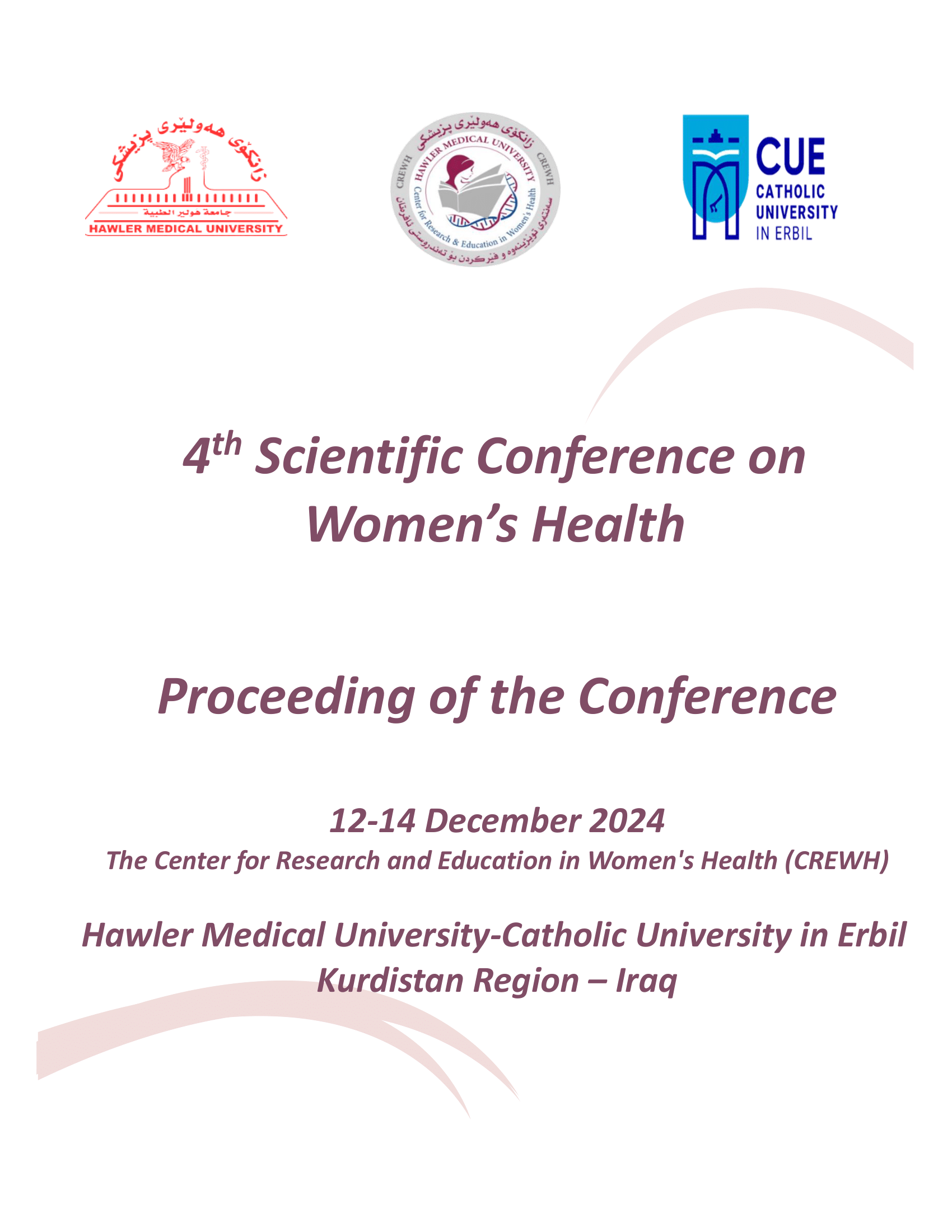Microbiological Analysis of Tissue Paper Pre- and Post-Exposure in Restrooms and its effects to women’s health
DOI:
https://doi.org/10.15218/crewh.2024.07Keywords:
Tissue paper, Isolation, Identification, Bacterial species, Fungal species, hygiene, toiletsAbstract
Back ground and Objectives: Toilet tissue paper are sanitary paper that comes into direct contact with the body but at the same time they are a good place for growth of microorganism. The objective of this study was to isolate, identify and evaluate the presence or absence of bacterial and fungal contaminants present on tissue paper remained in toilets.
Methods: Ten toilet tissue paper brands commercially available in Erbil City were tested for bacterial and fungal examination before placing them in toilet (zero time) and after placing them in five (5) different sites that determined within the college of health sciences building’s toilets then the samples cultured on (Blood agar, Mannitol salt agar, PDA, and Nutrient agar) the microorganisms were identified based on their morphological characteristics and biochemical test (API 20E test).
Results: The study showed no bacterial growth found on the tissue paper before placing them in toilet while Aspergillus niger showed growth on (Gi, Al and NM) tissue paper before placing in toilet. After remaining of tissue papers in different toilet sites , Pseudomonas fluorescens isolated from female cafeteria (Selpak), Serratia liquefaciens isolated from cafeteria male (Solo) and students toilet for both gender (Gipsy), Salmonella spp. isolated from students toilet for both gender (Limpio), Staphylococcus aureous isolated from female dean (Alwazir), Bacillus sp. isolated from dean building (Fine) and male and female cafeteria(Papia and Selin), Clostridium tetani isolated from female dean (Familia and Alwazir ) and dean building (No brand), and finally, Streptococcus spp. have isolated from male cafeteria (Solo). The fungi that have been isolated from these sites were (Aspergillus niger, Aspergillus candidus, Rhizopus oryzae, Penicilium citrinum, Penicilium camemberti, Aternaria alternate)
Conclusion: Different bacteria and fugal species identified after remaining the tissue papers in toilet sites that indicate transmission of bacteria present in toilet to tissue papers. contaminated toilet tissue can pose serious health risks for women, including urinary tract infections and vaginal infections due to exposure to harmful bacteria and fungi.
References
Singh SP. Fiber from Forest and Their Importance in Modern Time. Non-Timber Forest Products: Food, Healthcare and Industrial Applications: Springer; 2021. p. 427-53. DOI: 10.1007/978-3-030-73077-2_18.
Snow RD. Wood properties and utilization of assorted hardwoods: Mississippi State University; 2022.
Gendron LM, Trudel L, Moineau S, Duchaine C. Evaluation of bacterial contaminants found on unused paper towels and possible postcontamination after handwashing: a pilot study. American journal of infection control. 2012;40(2):e5-e9. DOI: 10.1016/j.ajic.2011.12.011.
Harrison WA, Griffith CJ, Ayers T, Michaels B. Bacterial transfer and cross-contamination potential associated with paper-towel dispensing. American journal of infection control. 2003;31(7):387-91. DOI: 10.1016/S0196-6553(03)00079-8.
Jane OC, Somadina OI, Chukwuma OU, Ogonna US, Catherine ON, Chinyere N. Bacteriological Assessment of Tissue Papers Sold in Eke Awka Market in Anambra State, Nigeria.
Saldmann F. Wash Your Hands: Dirty Truth About Germs, Viruses and Epidemics... and the Simple Ways to Protect Yourself in a Dangerous World: Grand Central Publishing; 2008.
Reynolds K, Hurst C. Manual of Environmental Microbiology. 2nd Annual Public Health Association. 2005:1-9.
Ogunshe AA, Oyebajo OE, Odusanya OA, Ogungbesan OA. Evaluation of Physical Characteristics and Public Health Significance of Easily-Culturable and Clinically-Relevant, Inhalable Microbial Flora of Unused Toilet Rolls. Health Science Journal. 2015;9(6).
Bashir S, Muhammad H, Sani N, Kawo A. Isolation and identification of bacterial contaminants from door handles of public toilets in federal university Dutse, Jigawa State-Nigeria. IOSR Journal of Pharmacy and Biological Sciences. 2016;11(5):53-7.
Basu P. Production of chlamydospores of Phytophthora megasperma and their possible role in primary infection and survival in soil. Canadian Journal of Plant Pathology. 1980;2(2):70-5. DOI: 10.1080/07060668009501441.
Samson R, Hoekstra E, Lund F, Filtenborg O, Frisvad JC. Methods for the detection, isolation and characterisation of food-borne fungi. 2004.
Doern GV, Chapin KC. Determination of biotypes of Haemophilus influenzae and Haemophilus parainfluenzae a comparison of methods and a description of a new biotype (VIII) of H. parainfluenzae. Diagnostic microbiology and infectious disease. 1987;7(4):269-72. DOI: 10.1016/0732-8893(87)90143-X.
Kateete DP, Kimani CN, Katabazi FA, Okeng A, Okee MS, Nanteza A, et al. Identification of Staphylococcus aureus: DNase and Mannitol salt agar improve the efficiency of the tube coagulase test. Annals of clinical microbiology and antimicrobials. 2010;9:1-7. DOI: 10.1186/476-0711-9-23.
Corry JE, Curtis G, Baird RM. Handbook of culture media for food microbiology: Elsevier; 2003.
Amala SE, Ade AJ, Bloomfield F. Bacteria associated with toilets and office lock handles. International Journal of Epidemiology and Infection. 2015;3(1):12-5. DOI: 0.12966/ijei.02.02.2015.
Ashgar SS, El-Said HM. Pathogenic bacteria associated with different public environmental sites in Mecca city. 2012:DOI: 10.4236/ojmm.2012.24020.
Ajayi A, Ekozien M. Sensitivity profile of bacterial flora isolated from bathroom. Elite Research Journal of Biotechnology and Microbiology. 2014;2(1):1-3.
Zhad P, Zhad M, Doyle J, Meng J. Development of a model for monitoring surfaces hygiene and environmental sanitation. International Journal of Infection Control. 1998;6(3):45-8.
Hamada N, Abe N. Physiological characteristics of 13 common fungal species in bathrooms. Mycoscience. 2009;50(6):421-9. DOI: 10.1007/s10267-009-0500-6.
Downloads
Published
How to Cite
Issue
Section
License
Copyright (c) 2025 Sewgil Anwer, Kawther A. Muhammad Saeed, Muzhda Qader, Zena Ali, Esra Esmail, Awaz Shekh, Sara Shakir

This work is licensed under a Creative Commons Attribution-NoDerivatives 4.0 International License.











